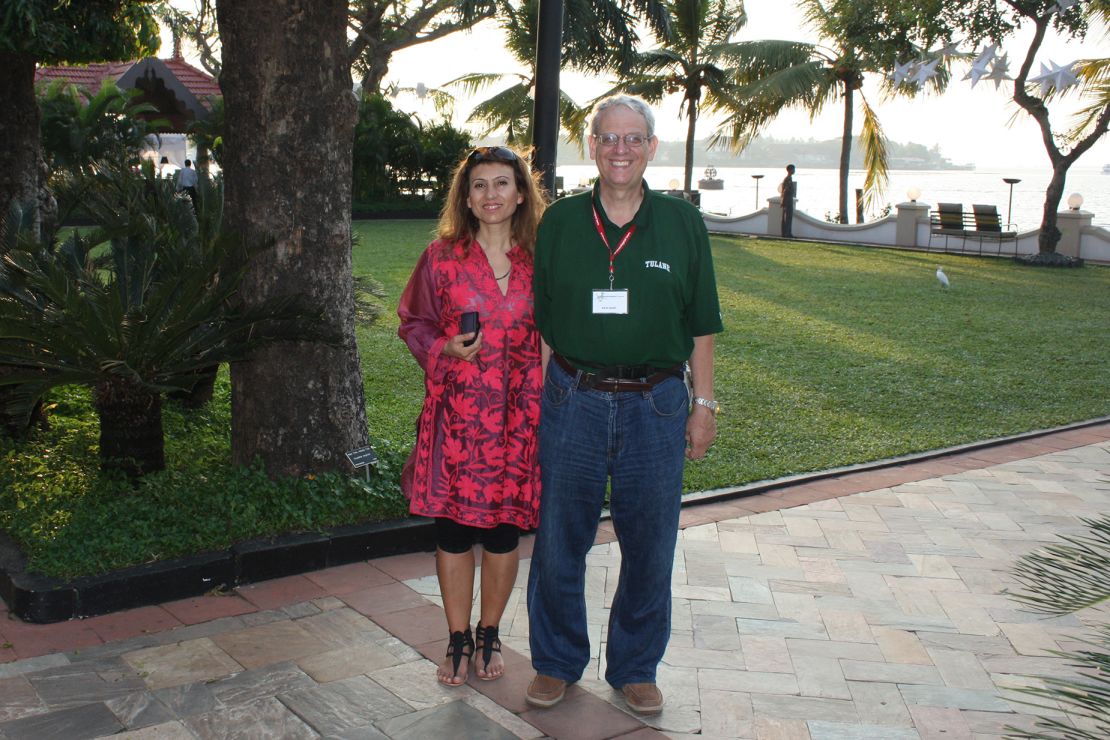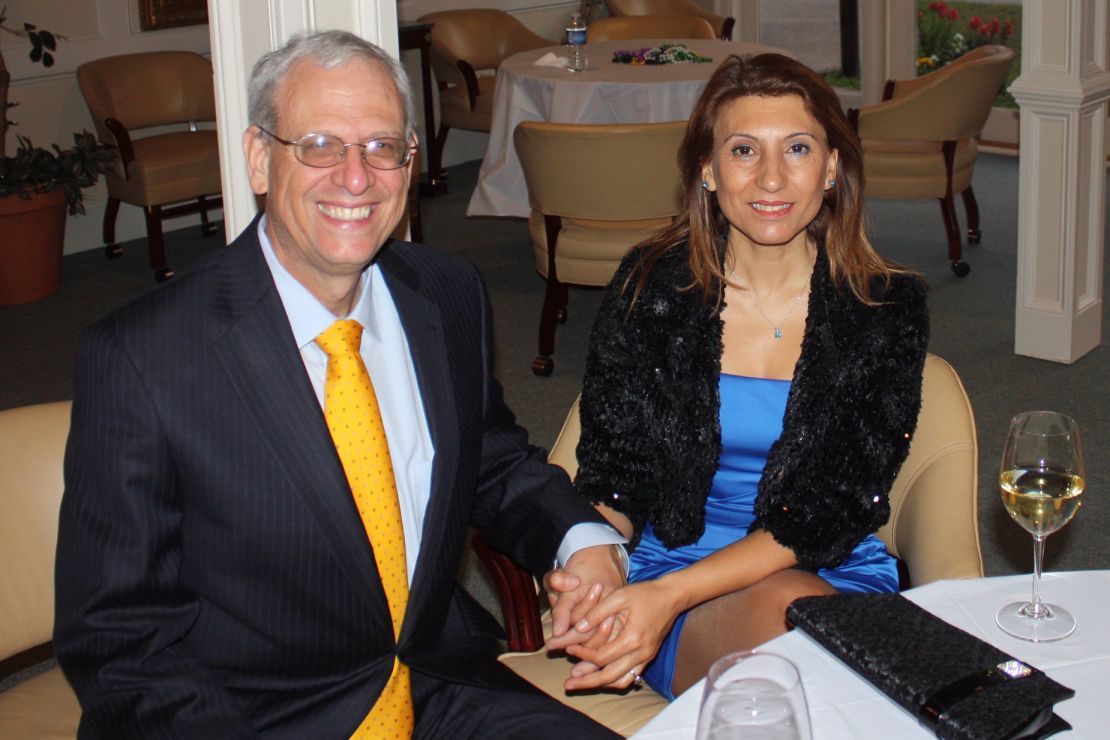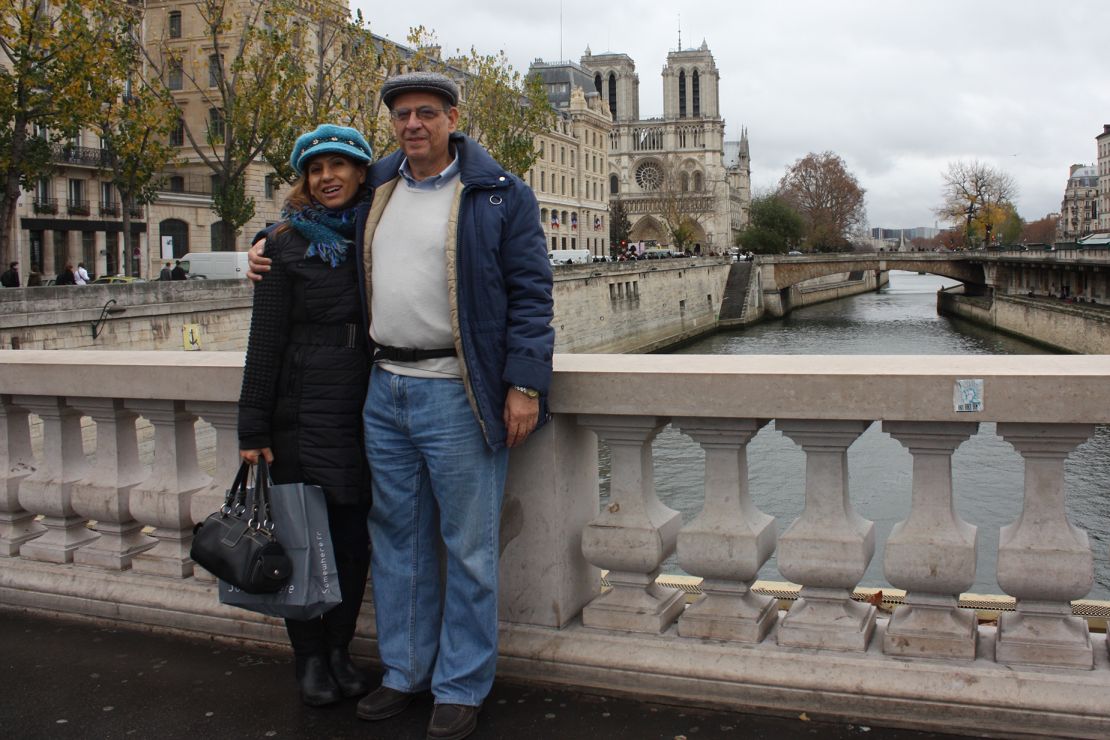The moment Kenneth Harl first saw Sema Tekgul, everything changed.
“I was instantly struck with love at first sight,” Kenneth tells CNN Travel today. “This was very strange for me, because I had been single all my life, very much dedicated to my teaching and my research, and never really thought I was ever going to get married.”
Kenneth and Sema crossed paths on June 15, 2011, in Malatya, Turkey.
Kenneth, then a 60-year-old professor of classical and Byzantine history at Tulane University in New Orleans, was traveling with his former graduate student turned close friend Jason, and their mutual acquaintance Yasmine, another Tulane professor with links to the country.
The trio planned to spend several weeks exploring, with Kenneth focused on tracking Roman military routes and researching his next history book. The group was especially excited to marvel at the imposing, mysterious stone faces carved into the rock at Nemrut Dağ, a UNESCO World Heritage Site.
In the lead up to the trip, Yasmine mentioned the plan to an old friend of hers, Sema Tekgul, a teacher from Izmit, Turkey. When Sema expressed interest in Nemrut Dağ, Yasmine invited her to join the excursion.
Kenneth welcomed this suggestion, despite knowing next to nothing about Sema.
“I agreed because four is an ideal travel group,” he recalls today.
Kenneth’s attention was on Nemrut, his book proposal and his research. Nothing could have prepared him for the moment he locked eyes with Sema in the lobby of a Malatya hotel. He was taken aback and captivated.
It was a “remarkable feeling,” says Kenneth, one he’d never experienced before.
“And when she looked at me, Sema seemed to have a similar electric feeling,” Kenneth says. “At dinner in that hotel, we were just sort of looking at each other. Sema at the time spoke no English, and I have only rudimentary Turkish … but there was something magical that happened.”
An intriguing proposition
Back in 2011, Sema was in her early 50s. She was content with her life in Izmit, a city in the northwest of Turkey, focused on work, family and friends. She’d never married – she’d been in love only once, as a younger woman, and it hadn’t worked out.
“I never expected marriage,” Sema tells CNN Travel today.
When Yasmine invited her to join the road trip across Turkey, Sema happily accepted. She was intrigued – not just by the prospect of Nemrut Dağ’s stone faces but also at the prospect of meeting the visiting Americans.
“It would be the first time I would meet Americans,” says Sema. “I knew nothing about them.”
And then, when she was introduced to Kenneth, Sema also felt an instant connection to him.
“I saw his soul through his eyes, and I was interested in him,” she recalls. “I showed with my eyes how much I like him.”
Sema wondered what Kenneth’s story was.
“I did not know if he was married,” she says. “I was very curious about him, but it would have been impolite to ask about his marital status.”
Kenneth wanted to know more about Sema, but was similarly cautious and polite, worried he might overstep a line.
“I thought she was too young for me. I thought, ‘Here is someone so nice, but too late in my life.’ And then I found out her age when we were at Nemrut.”
There were only eight years between them: Sema was 52 to Kenneth’s 60.
“Then I thought ‘Well, maybe …’ ” recalls Kenneth.
Growing closer

Over the next few days, as Kenneth, Sema and their friends Jason and Yasmin drove across Turkey, Kenneth and Sema grew closer.
“I was constantly looking at her and she was looking at me, we’re making eye contact. And it’s as if I could see into her soul. And I was just overwhelmed, it was completely unexpected and unplanned,” recalls Kenneth.
It was Sema who first voiced her feelings out loud.
“Do you believe in love at first sight?” she asked him. They were on a ferry boat, crossing the Euphrates River, standing side by side.
“Yes,” said Kenneth, smiling at her, finding himself almost unable to speak.
“I like you very much,” said Sema.
There wasn’t much more to say. Kenneth and Sema spent the rest of the ferry crossing basking in the glow of each other’s affection.
“I just felt that I wanted to be near her and learn about her,” says Kenneth. “And I just felt this was right. I had been alone for so long.”
Nemrut Dağ was as impressive and striking as the group had hoped. There were other highlights, too.
“At Malatya, Jason and I explored the Roman legionary camp, Hittite excavations and the archaeological museum,” Kenneth recalls. Then the group traveled to Urfa, a city in southeast Turkey.
“In Urfa, the four of us attended a dinner and traditional dance performance in the evening,” recalls Kenneth.
Kenneth wasn’t usually a dancer, but he found himself swaying to the music with Sema at his side.
“We got up and were dancing together,” he says. “Something I’d never done before. It was a lot of firsts.”
After Urfa, Yasmine went her own way, while the rest of the group headed to Harran. Once they got there, Jason – who’d sensed the connection between Sema and Kenneth from the beginning – encouraged the two of them to eat dinner alone while he made himself scarce.
Kenneth and Sema viewed the evening as their first official date.
“We spent the time in Urfa. We went to the beautiful gardens there and wandered around,” recalls Kenneth. “And when I came back to the hotel, Jason looked at me and said, ‘You know, I’ve known you a long time. If you were any other American, I would ask you what your intentions are to this woman. But I know you. You want to marry her.’ ” And I said, ‘Yes, I do. I was ready to marry her when I first saw her.’ ”
To Jason, the connection between Kenneth and Sema was apparent from the outset. It was undeniable by the time the group reached Nemrut Dağ.
“At Nemrut, you only took pictures of her,” Jason told Kenneth. “That’s when I knew. You never take pictures of people – you’re always chasing people away so you can get a clear shot of whatever it is.”
After the evening in Urfa, Sema had to return home to Izmit. But Kenneth and Jason had a few more weeks left in Turkey before they were set to return to the United States, so Kenneth and Sema arranged to meet in Istanbul later in the month.
“She was waiting for me in our hotel near the Blue Mosque,” recalls Kenneth. “We had dinner together, and I walked her back to her hotel. The next day, we spent the day at Büyük Ada (Princes’ Island).”
As Sema and Kenneth said their goodbyes, Sema suggested they exchange email addresses and Skype contact details. Kenneth, who is more old school, suggested they write letters – a romantic idea but not particularly practical.
“So I helped him learn Skype,” says Sema, laughing.
And then, over the next month, Kenneth and Sema connected every day, talking about their feelings for one another and their potential future. They were candid about how they felt about one another.
They both agreed: “Given our age, what is the advantage of waiting? How much time do we have?” as Kenneth recalls it today.
And so just over five weeks later, Kenneth returned to Turkey, arranging to meet Sema in Istanbul.
“I knew that he would ask to marry me,” says Sema. “He said on Skype that he had an important question to ask me in person when he came back to Istanbul. Then, I hoped that he would ask to marry me.”
Kenneth did propose to Sema that evening – speaking the words in halting Turkish. Sema said yes. It was an emotional, joyous moment.
“I did not consider any practical issues such as green card, learning English or living in the US,” says Sema. “I took a great risk based solely on feelings.”
“This feeling hit me, and I went with it,” agrees Kenneth. “I could have talked myself out of it pretty easily – being older, set in my ways: ‘Oh, it’d be better off not to get involved. Oh, I could get disappointed.’ I think anytime you plunge into a romance that leads to marriage, it’s a risk. But if the feelings are as powerful as I felt, you should take the risk.”
Making a commitment

Kenneth and Sema saw no point in waiting, putting off the proposal or wavering. They’d waited long enough – all their lives – to feel this way.
“I was deeply in love with her,” says Kenneth. “The next thing I was on a bus to Izmit, where her family lives.”
It was a whirlwind visit. Kenneth was introduced to Sema’s sister and nieces, who welcomed him warmly.
“I spent five hours with four Turkish women trying to present myself as an honorable man,” he recalls. “And somehow I knew I passed, because the next day I was invited to lunch at her sister’s house.”
Sema says her family really enjoyed meeting Kenneth and could sense their love for each other.
“They were all very happy for me, and they liked Ken,” says Sema. “My family is very tolerant.”
Not everyone was as encouraging. Kenneth’s sister was concerned he was swept up in his feelings and questioned how her brother would navigate the language barrier with Sema. Some friends bluntly suggested “the marriage would never last.”
But many others were touched by the pure joy that seemed to be radiating off Kenneth and Sema.
One of Kenneth’s good friends told him, “You seem like someone experiencing first love at age 16, not aged 60.”
And as for Kenneth and Sema, they had no concerns – even once they realized that securing Sema a fiancée visa was a long and complex process.
“My only word to any fellow citizens of the United States, is that if you fall in love with a foreigner, you better really love that person – because the US government puts you through so many hula hoops in order to get permission to marry,” says Kenneth. “It must have taken us about a year and a half. And that was fast.”
During that interim period, Kenneth spent time in Ankara working at the American Research Institute in Turkey. He and Sema hosted a party in Istanbul where they introduced their respective family and close friends. The couple also spent time vacationing in Paris, southern India and London – and Sema also visited Kenneth in the United States to get a taste of what life there might be like.
Eventually, on December 30, 2013, Kenneth and Sema were married at Kenneth’s home in New Orleans. A small group of friends and family gathered to celebrate, including Kenneth’s friend Jason, who’d been witness to the love story from the beginning and now served as best man.
“It was a small group, and not a fancy wedding, which is not my character,” says Sema. “What was special to me was my wedding dress, which was handmade in Turkey.”
Kenneth says he felt “almost intoxicated” with the joy and excitement of the event. The wedding was both a celebration of his two years with Sema and a promise for their shared future.
Life in New Orleans
Post-wedding, Sema changed her name to Sema Tekgul Harl and settled into life in New Orleans. She liked that it was a small, tolerant city with a vibrant sense of character. She connected with other women of Turkish heritage, retired from her schoolteacher job back home and enrolled in college to learn English.
Meanwhile Kenneth, who was still working as a professor at Tulane, worked hard to improve his Turkish skills.
The language barrier meant there were occasional mix-ups, but Sema and Kenneth suggest it was never a real problem.
It’s pretty easy to communicate, says Kenneth, “as long as the feelings are there.”
“And we always keep a dictionary nearby,” adds Sema, laughing.
“That’s part of the fun of what people would call an international marriage, you’re always finding out how the other person interprets the world, because language is an interpretation of the world,” says Kenneth.
More of an adjustment was living together, given they’d each spent decades living alone. Sharing their everyday life with another was exciting and special but also a new experience.
“I never expected marriage, it was a surprise for me. I was 52 years old,” says Sema. “I didn’t think marriage was in my life.”
“I had love interests before, but they never developed at all in any significant way, and I was long resigned to never getting married,” says Kenneth. “I thought that would be OK. Because I was devoted to teaching and to my studies. Then, this feeling hit me and I went with it.”
The couple embarked on the learning curve together.
“I felt like I made a lot of mistakes, because I was so nervous,” says Kenneth of the early years. “And sometimes I’m still nervous about whether I am doing a good job.”
The key, he suggests, is approaching both ups and downs with empathy, humor and love.
At the end of last year, Sema and Kenneth celebrated their 10-year wedding anniversary.
The past decade hasn’t always been easy. Sema loves Kenneth, loves New Orleans, but also misses what she calls her “before life.” Sema suggests these multiple, different emotions can co-exist – but her overwhelming emotion is joy at having found Kenneth and gratitude for their mutual willingness to jump into an unexpected new chapter.
“It’s worth the gamble, especially late in life,” agrees Kenneth.
Bittersweet but perfect

One day, near the start of their relationship, Sema turned to Kenneth and asked him a question.
“Why couldn’t we have met 20 years ago?” she said, wistfully.
Sema was thinking about the children they might have had, the extra time they could have enjoyed – and the years they spent alone.
She knew Kenneth had traveled to Turkey as a younger man on numerous research trips. They could have crossed paths earlier. The first half of their lives now felt infused with a sense of almost-connections, what ifs and could-have-beens.
“I’m also sad that I did not have children with Sema,” says Kenneth, who says he’d have loved to be a father. While considering what could have been is bittersweet, Kenneth points out he and Sema worked as educators, influencing the lives of many young people. Kenneth remains pleased and proud whenever he hears from former students, and that’s something he and Sema have in common.
“Repeatedly, in Izmit, I met accomplished individuals, men and women, who were once Sema’s students, and they all recall fondly their days as students with her,” he says.
And while thinking of what might have been is sometimes emotional, Kenneth and Sema also see advantages in falling in love with one another later in life.
“You’re more tolerant, you’re more willing to learn,” says Kenneth. “And you begin to realize that time is probably the most important commodity at this point in your life, and time together becomes extremely important.”
Before meeting, Kenneth and Sema also endured hardships that they had to tackle solo. Sema lived in Izmit during a catastrophic 1999 earthquake. Kenneth had to evacuate New Orleans during Hurricane Katrina in 2005. Sema and Kenneth both cared for, and lost, elderly parents.
“We have experienced similar loneliness in our lives,” says Kenneth.
Whatever the future, knowing they now tackle life side by side is reassuring, affirming, exciting.
“We feel a mutual affection for the safety and goodwill of each other. So long as we are together, the activity is secondary. There is just a powerful feeling that we belong together,” says Kenneth.
Kenneth retired from teaching at Tulane a couple of years ago. He and Sema now devote their time to travel and exploring together. They frequently visit Turkey and hope to split their time evenly between Turkey and the United States in the future.
“We love traveling together. She loves to walk and explore cities and see natural beauty. We’ve had so much fun together and sharing different trips,” says Kenneth. “We would never have met each other if we hadn’t been so addicted to traveling.”
Today, looking back at the moment he first crossed paths with Sema, over 13 years ago, Kenneth says the circumstances of their meeting makes him think of the ancient Greek word “Kairos.”
“Kairos is the moment and opportunity, and it only comes very, very seldom, as a gift of the gods, and you seize it,” he says. “Our meeting was Kairos. It was that opportune moment. And it would never happen again. If you feel like that, then seize it. I’m thankful every day I wake up that I’m married to her.”
“The entire experience was not logical,” says Sema. “I went with my feelings. I love him, because he’s a good man. He’s not just my husband, he’s my good friend. He’s really my family.”







